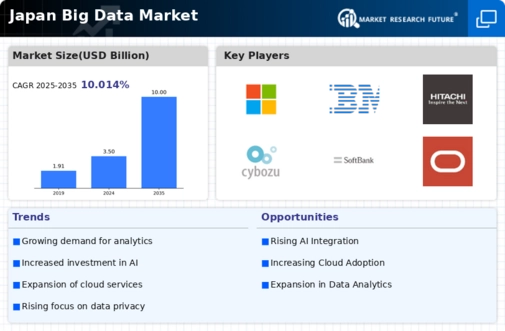The big data market in Japan is characterized by a dynamic competitive landscape, driven by rapid technological advancements and increasing demand for data-driven decision-making across various sectors. Major players such as IBM (US), Microsoft (US), and Oracle (US) are strategically positioned to leverage their extensive portfolios and innovative capabilities. IBM (US) focuses on integrating AI and machine learning into its big data solutions, enhancing analytics and operational efficiency. Microsoft (US) emphasizes cloud-based services, particularly through Azure, which facilitates scalable data management and analytics. Oracle (US) continues to strengthen its offerings in database management and cloud applications, aiming to capture a larger share of the enterprise market. Collectively, these strategies foster a competitive environment that encourages innovation and collaboration among key players.
In terms of business tactics, companies are increasingly localizing their operations to better serve the Japanese market, optimizing supply chains to enhance efficiency and responsiveness. The competitive structure of the market appears moderately fragmented, with several players vying for dominance. However, the influence of major corporations remains substantial, as they set industry standards and drive technological advancements that smaller firms often follow.
In October 2025, IBM (US) announced a partnership with a leading Japanese telecommunications company to develop advanced data analytics solutions tailored for the local market. This collaboration is expected to enhance IBM's presence in Japan, allowing it to tap into the growing demand for data-driven insights in telecommunications. The strategic importance of this partnership lies in its potential to combine IBM's technological expertise with local market knowledge, thereby creating customized solutions that address specific customer needs.
In September 2025, Microsoft (US) launched a new initiative aimed at promoting AI-driven analytics tools for small and medium-sized enterprises (SMEs) in Japan. This initiative is significant as it not only expands Microsoft's customer base but also democratizes access to advanced analytics capabilities, enabling SMEs to leverage data for competitive advantage. By focusing on this segment, Microsoft positions itself as a leader in fostering innovation among smaller businesses, which are crucial to Japan's economic landscape.
In August 2025, Oracle (US) unveiled a new cloud-based platform designed to streamline data integration and management for Japanese enterprises. This move is strategically important as it aligns with the increasing trend towards cloud adoption in Japan, allowing Oracle to enhance its service offerings and attract more clients. The platform's capabilities are expected to facilitate seamless data flow and improve operational efficiency, thereby reinforcing Oracle's competitive position in the market.
As of November 2025, current trends in the big data market include a strong emphasis on digitalization, sustainability, and the integration of AI technologies. Strategic alliances are increasingly shaping the competitive landscape, as companies recognize the value of collaboration in driving innovation and expanding market reach. Looking ahead, competitive differentiation is likely to evolve, with a shift from price-based competition towards a focus on innovation, technological advancement, and supply chain reliability. This transition underscores the importance of agility and responsiveness in meeting the evolving demands of the market.
























Leave a Comment